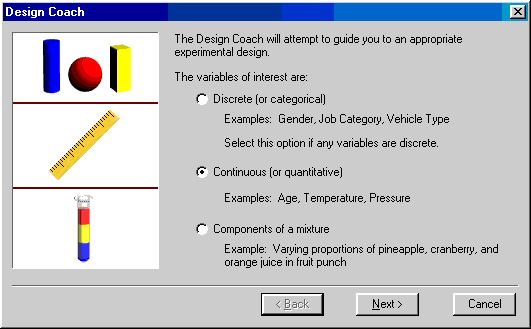Types of experimental design
Types of experimental design
There are four major categories of experimental design:
- Factorial: These designs are used to identify important effects. These designs answer "yes or no" questions such as whether or not gender, race, or an interaction of two makes a difference in the effectivness of Web-based instruction.
- Response surface: These designs answer more specific questions. They are used to find the combination of factor values that gives the highest or lowest response. For example, a Web course designer wants to find the particular combinations of links and graphics in a single webpage to achieve the best readability.
- Mixture: These designs go further than response surface designs in specification. They can be viewed as a specific category of response surface designs. They are used to find the ideal proporations of ingredients of a process involving mutiple factors.
- Optimal: These designs are used when you have enough information available to give a very detailed specification of the model to be tested.
 In social sciences factorial designs are commonly used, because in most cases social science reseach does not have a high degree of specification as physical science and engineering science research. The following are some examples of factorial designs:
In social sciences factorial designs are commonly used, because in most cases social science reseach does not have a high degree of specification as physical science and engineering science research. The following are some examples of factorial designs:
- Completely randomized factorial designs
- Randomized block designs
- Repeated measures designs
- Analysis of covariance designs
- Balanced incomplete block designs
- Latin square designs
- Spilt-plot designs
Explaining the above designs are beyond the scope of this class. Students are encouraged to take at least one class in design of experiment.
Trial Run
There are quite a few software applications for design of experiment. I recommend Trial Run by SPSS (1998) for its user-friendliness. Trial Run has a wizard named Design Coach, which can walk you though an experiment design. The following slide show is an example. Please use the navigation buttons below the picture to walk through the simulated design process (The following simulation may not work on Internet Explorer).

You may look at an interactive simulation of Trial Run, which requires the Shockwave plug-in.
Reference
 Go up to the main menu Go up to the main menu
|
|

 In social sciences factorial designs are commonly used, because in most cases social science reseach does not have a high degree of specification as physical science and engineering science research. The following are some examples of factorial designs:
In social sciences factorial designs are commonly used, because in most cases social science reseach does not have a high degree of specification as physical science and engineering science research. The following are some examples of factorial designs: